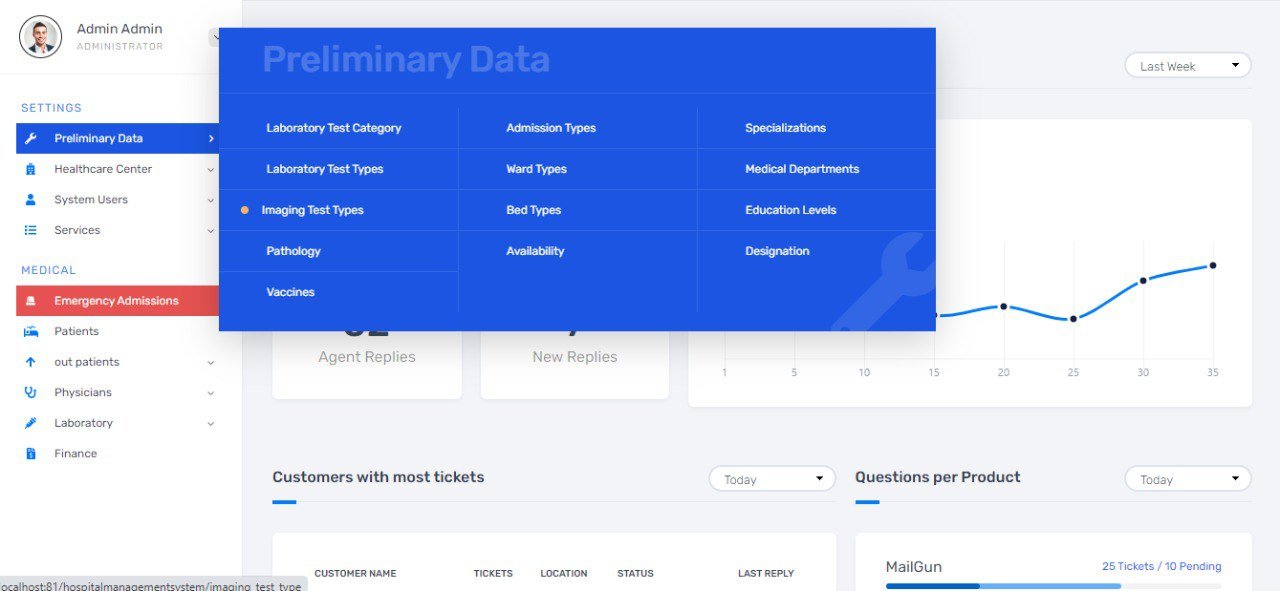Système de gestion hospitalière
patients, le tri de leurs données dans le système, ainsi que la facturation informatisée.
Le logiciel a la capacité de fournir une fonction de recherche pour chaque patient et le personnel automatiquement.
Le système de gestion hospitalière peut être accessible en utilisant un nom d'utilisateur et un mot de passe. Il est accessible soit par un administrateur, soit par un réceptionniste.
Les données peuvent être récupérées facilement. L'interface est très conviviale. Les données sont bien protégées pour un usage personnel et un traitement rapide des données. Le système de gestion hospitalière est conçu pour les hôpitaux multiservices, afin de couvrir un large éventail d'établissements.



Création d'une solution complète Plateforme en ligne pour les hôpitaux multispécialisés
Vue d'ensemble
Le site web du Système de Gestion Hospitalière (SGH) a été développé pour améliorer l'efficacité opérationnelle des hôpitaux multispécialisés. En tirant parti de la puissance d'Angular pour le frontend et de .NET pour le backend, cette plateforme gère les informations des patients, les détails du personnel et les processus de facturation de manière fluide, permettant aux hôpitaux de se concentrer sur la prestation de soins de haute qualité.
Exploration
Les hôpitaux sont souvent confrontés à des difficultés pour gérer de grands volumes de données, traiter des facturations précises et sécuriser des informations sensibles. Les systèmes existants étaient souvent obsolètes, entraînant des inefficacités et un risque accru d'erreurs. Pour résoudre ces problèmes, nous avons lancé une phase d'exploration approfondie, incluant des entretiens avec les parties prenantes et une analyse approfondie des systèmes existants.
Constatations clés :
- Conception dépassée: Les systèmes précédents étaient encombrants, avec une interface désordonnée qui frustrait les utilisateurs.
- Gestion des données inefficace: L'absence d'un système intégré entraînait une récupération et un traitement des données lents.
- Problématiques de sécurité: Des mesures de sécurité inadéquates rendaient les données sensibles des patients et du personnel vulnérables.
Sur la base de ces constatations, nous avons tracé une voie claire pour développer un système moderne, sécurisé et efficace qui rationaliserait les opérations hospitalières.
Stratégie UX
Après avoir recueilli des insights lors de notre phase de découverte, nous nous sommes concentrés sur la création d'une expérience utilisateur (UX) intuitive et efficace pour le site web du SGH
Actions clés:
- Refonte de la carte du site: Nous avons simplifié la navigation pour permettre aux utilisateurs d'accéder facilement aux informations critiques.
- Stratégie de contenu: Le contenu obsolète a été supprimé, et un nouveau contenu pertinent a été créé pour refléter avec précision les services de l'hôpital.
- Maquette filaire: Nous avons développé des Maquette filaire qui privilégiaient les parcours utilisateur, garantissant une expérience optimale dès que les utilisateurs arrivent sur le site.
Développement
Avec la structure en place, la phase de développement est celle où le site web du SGH a vraiment pris vie.
Conception & Développement:
- Conception: Nous avons opté pour un design épuré et professionnel, en utilisant une palette de couleurs apaisantes qui reflète le sérieux et la fiabilité d'un environnement de soins. Le design est responsive, garantissant une expérience cohérente sur tous les appareils.
- Développement Front-End: Développé avec Angular, le frontend est rapide, responsive et convivial.
- Développement Back-End: Le backend, propulsé par .NET, garantit des performances robustes et une sécurité optimale, gérant la gestion complexe des données et l'authentification des utilisateurs de manière fluide.
Test & Lancement
Avant le lancement, nous avons effectué des tests approfondis sur plusieurs appareils et navigateurs pour garantir une expérience fluide et sans erreur.
Phases de test:
- Compatibilité mobile et desktop: Garanti une performance optimale sur toutes les tailles d'écran.
- Tests sur les navigateurs: Validé la fonctionnalité du site web sur différents navigateurs.
- Tests de sécurité: Mis en place et testé des protocoles de sécurité robustes pour protéger les données sensibles.
Une fois les tests terminés, nous avons suivi un processus Agile pour lancer la version du produit minimum viable (MVP) du site, avec des mises à jour ultérieures déployées par phases.
Résultats
Le site web du SGH offre désormais aux hôpitaux un outil puissant pour gérer leurs opérations plus efficacement.
Résultats clés:
- Efficacité améliorée: Réduction significative du temps consacré à l'enregistrement des patients et à la facturation.
- Sécurité renforcée: Des contrôles d'accès sécurisés protègent les informations sensibles, offrant aux hôpitaux une tranquillité d'esprit.
- Retours utilisateurs positifs: Le personnel hospitalier a salué le site pour sa facilité d'utilisation et la récupération rapide des données.
- Évolutivité: Le système peut facilement évoluer avec l'hôpital, s'adaptant à la croissance sans compromettre les performances.
